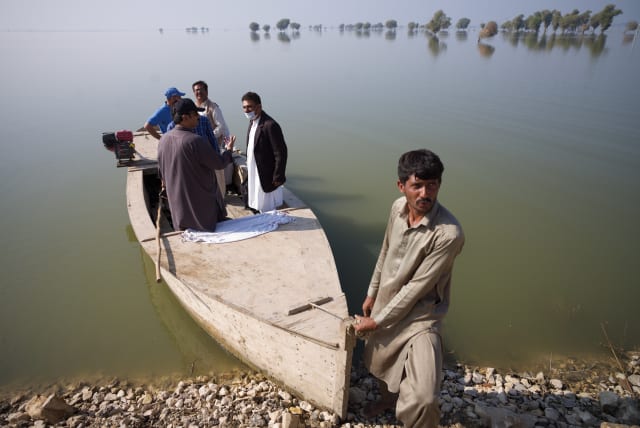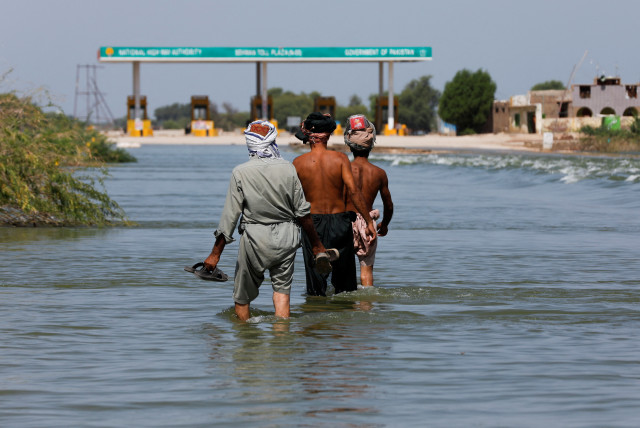Unrelenting deluge: At least 150,000 Displaced in Pakistan’s worst floods

Experts say that the main cause of the flood is a lack of stable and long-lasting policies to prevent the situation.
[Islamabad] Massive flooding ravaged Central Punjab on Sunday, submerging hundreds of villages and destroying thousands of hectares of crops, after the Sutlej River burst its banks. The ensuing devastation in nearby villages forced residents to flee and put many at risk of drowning.
“Approximately 150,000 individuals have been evacuated from flooded villages to safer places,” Farooq Ahmed, spokesman for Punjab Emergency Services, told The Media Line. “The flood has affected 22 districts in Punjab, with Kasur being the worst affected.”
“Sixteen people have died so far, 36 have been injured, and approximately 14 thousand pets and their owners have been safely relocated,” he continued.
Ahmed further told The Media Line that “to ensure the safety of flood victims, Punjab Emergency Services personnel are working round the clock to [utilize] all available resources.”
Pakistan’s National Disaster Management Authority (NDMA) has predicted more flooding in numerous towns and landslides in the mountainous area.
A statement issued by the NDMA said: “Heavy rains from the night of July 27 to July 29 may cause flooding in low-lying areas of Islamabad, Rawalpindi, Peshawar, Gujranwala, Lahore and Faisalabad. [This] may lead to landslides in hilly areas of Gilgit, Kashmir, Baltistan, and Khyber-Pakhtunkhwa.”
The Sutlej River is the longest of the five rivers that flow through the historic crossroads region of Punjab in northern India and Pakistan.
“The Sutlej River witnessed moderate to severe flooding after India dumped water into it and the Pakistan Meteorological Department issued a flood warning,” reported the Associated Press of Pakistan (APP), the country’s state news agency.
APP also stated that “the appropriate departments have relocated thousands of people, including men, women and children from communities along the Sutlej River’s path to safe locations, in accordance with the flood forecast division’s directives.”
Punjab Relief Commissioner Nabeel Javed told The Media Line that “the local administration in the districts adjacent to Sutlej River has been put on high alert and all the institutions have been kept ready to deal with any emergency.”
“24-hour monitoring is going on in the Provincial Disaster Management Authority (PDMA) control room,” he continued. “District Emergency Operation Centers, including Rural Reporting Centers, are also fully operational.”
Flood Rescue Activities in District Kasur and Vehari on 22 August, 2023.#flood2023 #PunjabFloods2023 pic.twitter.com/xfcurObkB4
— Punjab Emergency Service Department (@pesrescue1122) August 22, 2023
Mazhar Hussain, public relations officer for the PDMA, told The Media Line that “the districts of Bahawalnagar, Kasur, Okara, Pakpattan, Vehari, Multan and Lodhran have been recognized as vulnerable.”
“Villages around the Sutlej River are being evacuated. Food, shelter, medicines, boots, and other necessities are being distributed to neighboring district administrations, while all institutions remain on high alert,” he continued.
Hussain reported that the floods have affected 350 villages and harmed crops on 145778 acres. A total of 101 relief camps have been established.
He also stated that “85 medical camps have been set up to provide medical services to flood victims and more than 25,000 patients have been treated on these campuses so far.”
200 people have lost their lives in monsoon
Pakistan is currently experiencing monsoon rains that started at the end of June, which have created flooding in many areas. About 200 people have lost their lives during this year’s monsoon.
Major overflows of River Sutlej have wreaked havoc in the villages as floodwaters spread for hundreds of miles. The roads were either inundated or washed away by the raging floodwaters, which have completely cut off land connections.
“On Thursday morning, there was a high level of flooding at the Baba Fareed Bridge in the Sutlej River across the limits of Minchinabad,” according to rescue sources. “More than 150 communities’ land connections have been severed as a result of the increased flow of flood water.”
“The Sutlej River is roaring and overpowering at the moment. … More than 50 villages are cut off. A search and rescue operation is underway in the region.”
In June 2022, a flood submerged approximately one-third of Pakistan, killing 1,700 people, affecting about 33 million others, and damaging or destroying around 2 million homes as well as thousands of schools and hospitals.
That flood, which was aggravated by climate change, washed away crops and destroyed infrastructure and thousands of miles of roads, railway tracks, and bridges. It was regarded as the biggest disaster in the country’s history, with a $16 billion recovery budget.
Academic activities in Punjab were meant to resume on August 21 after the summer vacation, but the provincial education department has decided to keep schools in the flood-affected areas closed till the situation stabilizes.
Pakistan lasts stable flood policies
Experts say that the main cause of the flood and the devastation it has inflicted in Pakistan is a lack of stable and long-lasting policies to prevent the situation.
Noaman Abdul Majid is a Karachi-based economist, geopolitical analyst, and social development expert. He is the CEO of WiXeman Global, a strategy consulting firm practicing in the Gulf Cooperation Council countries and Pakistan.
Majid told The Media Line that “Pakistan’s economy is already going through its worst crisis in decades, mainly driven by current account deficits and political instabilities.”
“The floods will create more pressure on foreign exchange. Pakistan needs long-term planning and investment to address its climate and sustainability issues. Otherwise, these natural disasters will keep exacerbating in the coming years,” he continued.
“The global community has made several pledges to the government of Pakistan in the recent past to fight climate change, but they have not materialized. The reason is the lack of tangible homework on the part of the Pakistani system to plan and execute real impact-oriented projects,” Majid added.
Jazib Mumtaz, a Karachi-based senior research economist and analyst at the Policy Research Unit of the Federation of Pakistan Chambers of Commerce and Industry, told The Media Line that “climate change is making seasonal rains heavier and more unpredictable. However, with better management and technology the flood water can be saved for long-term prospects of agricultural revival and food security.”
“Pakistan is one of the countries that is most vulnerable to long-term climate risk,” he went on, pointing out that it is still struggling the recover from the 2022 floods that inundated almost a third of the country. “The country’s vulnerability to flooding is exacerbated by factors such as climate change, deforestation, inadequate urban planning, and a lack of proper water management systems.”
Mumtaz urged Pakistan to “urgently adopt and implement comprehensive, long-term policies to mitigate the devastating impact of continuous flood disasters.
“By prioritizing long-term strategies over short-term fixes, Pakistan can proactively reduce the frequency and severity of flood disasters, safeguarding lives, livelihoods and critical infrastructure,” he added.
Mumtaz also noted that “Pakistan may drastically reduce the frequency and severity of flood disasters by incorporating such solutions into a cohesive and forward-thinking framework, protecting lives, livelihoods, and infrastructure for future generations.”
Jerusalem Post Store
`; document.getElementById("linkPremium").innerHTML = cont; var divWithLink = document.getElementById("premium-link"); if (divWithLink !== null && divWithLink !== 'undefined') { divWithLink.style.border = "solid 1px #cb0f3e"; divWithLink.style.textAlign = "center"; divWithLink.style.marginBottom = "15px"; divWithLink.style.marginTop = "15px"; divWithLink.style.width = "100%"; divWithLink.style.backgroundColor = "#122952"; divWithLink.style.color = "#ffffff"; divWithLink.style.lineHeight = "1.5"; } } (function (v, i) { });

